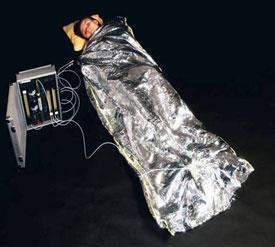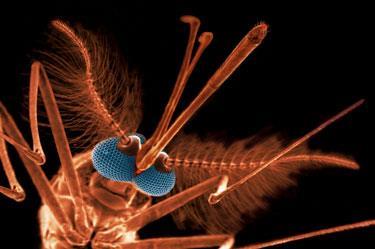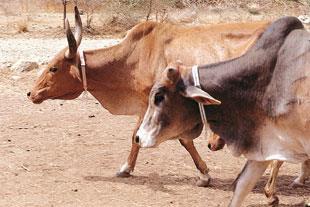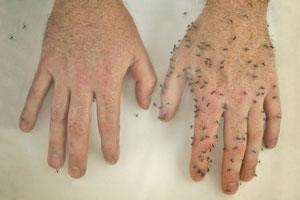Simon Hadlington discovers why some people get bitten by more insects than others, and how new chemical deterrents are helping fight them off
Simon Hadlington discovers why some people get bitten by more insects than others, and how new chemical deterrents are helping fight them off
As the summer draws to a close, so too that familiar refrain from the hills and forests gradually fades: ’Ouch! You *%$@#!’ accompanied by the sound of a sharp self-administered slap to the back of the neck.
Biting insects may be the curse of tourists seeking tranquillity in the wilderness, but they are more than a mere nuisance. Midges in Scotland might make our holidays uncomfortable, but in other parts of the world, pathogens carried by such pests cause millions of deaths a year through diseases such as malaria and dengue fever. And humans are not the only victims; livestock also fall prey to these insects, transmitting diseases such as bluetongue in sheep, and causing enormous economic damage.
Furthermore, there is evidence that the situation may be getting worse - changing global climate patterns could be responsible for some of these diseases now being seen in parts of the world that were previously unaffected.
So the question is, what can we do about the problem? One answer is to look for more efficient repellents for these insects or to lure them into traps. Either way, what is needed is a deep understanding of the chemical cues these insects use to track their victims.
Sniffing out clues
Over many years, Mike Birkett and his colleagues at the biological chemistry department at Rothamsted Research in the UK, have carried out extensive and pioneering research into understanding the role and identity of chemical cues, also known as semiochemicals, that mediate the behaviour of insects.
’Biting or blood-sucking insects use a number of stimuli to locate a suitable host,’ Birkett says. ’These include heat and vision, but olfaction, or smell, is extremely important - the insects rely on being able to detect semiochemicals emitted by the animal or human host into the environment.’
These semiochemicals tend to be small, volatile lipophilic molecules, ranging from carbon dioxide in the breath, through to more complex species which are predominantly metabolites arising from lipid or fatty acid metabolism at or near the skin’s surface. The precise origin of these volatile species remains unclear. ’We have quite a lot of lipid chemistry on our skin, and it remains to be determined whether volatile semiochemicals are generated by microbial degradation or under enzymic control,’ says Birkett.
The team at Rothamsted, in collaboration with a team at the University of Aberdeen, UK, carried out a series of pioneering experiments to identify the skin volatiles that were interesting
to mosquitoes, and, more intriguingly, those that were unattractive.
Wired for scent
First, volunteers’ hands were exposed to mosquitoes to determine how attractive a host each person was. They were then wrapped up in orienteering survival bags made from aluminised plastic sheeting (see Chemistry World , March 2005, p6). ’We passed a stream of purified air over the volunteers and trapped the volatiles in the air stream inside a porous polymer matrix,’ Birkett explains. These odour molecules were washed off the polymer using high purity solvent, producing a solution of ’body essence’ containing several hundred compounds.

Next came the really clever part - using established electrophysiology techniques, it is possible to insert microelectrodes into the antennae of a mosquito. These electrodes can detect electrical activity when the mosquito’s odour sensors are stimulated. The Rothamsted team fed the ’body essence’ mixtures into a gas chromatograph (GC) to separate the individual components, then split the effluent stream so that half passed to a wired up mosquito, with the other half passing over a flame ionisation detector. Each time the mosquito’s antenna ’lit up’, the corresponding molecule could be located, and subsequently identified using GC-mass spectrometry.
In this way, they were able to discover how the profile of volatiles varied between different people. ’What we discovered was not that the attractive hosts are producing something that is particularly enticing to the mosquito, but rather the unattractive host was producing something that interfered with the mosquito’s ability to locate a suitable host,’ says Birkett.
Two main molecules were found to be responsible for the interference, 6-methyl-5-hepten-2-one and geranylacetone. ’People who were bitten less were producing higher levels of these chemicals,’ Birkett explains. ’The key thing is that if you add these compounds to the skin, they suppress attraction. We believe they have high potential for use in personal protection because they work at ecologically relevant levels - in the nanogram range - and they are odourless to humans.’
Getting the message
Meanwhile, John Carlson’s lab at Yale University in the US is making important inroads into understanding the molecular basis of insect olfaction. ’Odorant molecules are detected by proteins called odorant receptors,’ explains group member Allison Carey. These receptors span the cell membranes at the surface of neurons (nerve cells) in mosquitoes’ antennae.
’When the receptor comes into contact with an odorant, there is probably some kind of conformational change, which ultimately leads to stimulation of the neuron and the sparking of an electrical signal - although the precise details are not clear,’ Carey adds. ’What we want to know is what happens at the very first step - what molecules can these odorant receptors bind to.’

The Yale team’s approach has focused on the genes that code for mosquitoes’ odour receptors. The relevant mosquito genes could be identified by correlation with the equivalent genes in the fruit fly Drosophila melanogaster due to strong similarities between the insects. The fruit fly is a commonly studied model organism whose genome was completely sequenced in 2000.
Ideally the mosquito genes could be transplanted into cultured cells, which would then produce the receptors for investigation. ’Unfortunately this turns out to be too difficult,’ Carey says. ’So what we have done is knock out an odorant receptor gene in Drosophila and replace it with the equivalent gene from the mosquito, so the fruit flies express mosquito receptors.’
A smelly code
In this way the team succeeded in producing some 50 active mosquito odorant receptors in the fruit fly model. They were then able to test a panel of around 100 volatile chemicals against each receptor to see which receptors were stimulated by which molecules.
’We found that for most of these receptors we could identify strong ligands,’ says Carey. ’For 34 of our 50 receptors we found something in our panel that excited the receptor. We then identified a number of receptors that were activated by volatiles found in human odours.’

But perhaps most significantly there was a small handful of receptors that were extremely narrowly tuned - binding only a small number of molecules, whereas the others bound to dozens to a greater or lesser degree. ’The more discerning receptors only bound to one or two compounds,’ Carey says. ’Nearly all of the most narrowly tuned receptors turned out to be tuned to biologically relevant chemicals, including those that had been identified as components of human odour or other biologically important odour sources. We found five or six such receptors and we think that they may be candidates for guiding mosquitoes towards a blood meal host.’
For example, one compound - 4-methylphenol - strongly activated one specific receptor. Another receptor produced a powerful response in the presence of indole. Both of these molecules are found in human sweat. ’They actually do smell pretty stinky,’ says Carey, ’4-methylphenol smells like sweaty gym socks!’
The team is now collaborating with insect behaviour experts in the Netherlands to see whether a mosquito’s behaviour is affected by the chemicals they have identified. ’One possibility is that we could use this information to develop traps to lure mosquitoes away from humans,’ Carey says. ’Or we could find a molecule that binds even more strongly and less reversibly than the natural odorant, and this could overwhelm the insect’s navigation and detection system.’
Now that they have identified the critical receptors, Carey thinks it will be possible to put them into cells and screen them against huge chemical libraries. ’We have a set of targets that could be screened for new repellents or masking agents,’ she says.
Animal magnetism
Biting insects transmit potentially lethal diseases to both humans and farm animals. In parts of Africa, tsetse flies carry parasitic trypanosomes, the cause of African animal trypanosomiasis in cattle - known locally as nagana. Related parasites in other species of tsetse fly cause human African trypanosomiasis, or African sleeping sickness.
At the International Centre of Insect Physiology and Ecology (Icipe) in Kenya, Baldwyn Torto’s team is using innovative techniques to identify potential tsetse fly repellents to combat nagana. One approach has been to analyse the body odours of animals that are not attractive to the fly to see if it is possible to identify repellent molecules.
One of these ’unattractive’ animals is the waterbuck, a species of African antelope. ’We collected body washes from waterbucks, biologically tested them in the laboratory and analysed them to identify the chemical components,’ explains Torto. He adds that they found a number of chemicals that were given off by waterbucks but not by domestic cattle, and that a blend of these components repelled tsetse flies in the team’s laboratory tests. By systematically removing individual components from the blend - a strategy known as a subtractive bioassay - the active repellent compound was singled out. ’Synthetic analogues of this aromatic component were then made and tested in laboratory assays,’ Torto adds.

One of these analogues was highly repellent to tsetse flies. To test its effectiveness in the field, it was formulated and fitted to collars for cows owned by nomadic cattle herders. By equipping 75 per cent of cattle with these collars, Icipe scientists demonstrated that an entire herd - and the herdsmen - can be protected from the biting insects.
On the shores of Lake Victoria in western Kenya, Torto’s team is conducting another trial, this time against the species of tsetse fly that spreads sleeping sickness in humans. In Africa, about 300 000 cases of the disease are reported annually. The drugs available for treating this disease are old, hard to administer, and cause debilitating side effects. ’In east Africa, 90 per cent of the blood meal taken by this species of tsetse fly is from monitor lizards,’ says Torto. ’This indicates strongly that odours from this lizard are attractive to these flies.’ Together with Birkett’s group at Rothamsted and a team at the Liverpool School of Tropical Medicine in the UK, Icipe is looking to identify the relevant molecular cues from the lizard to develop attractant baits and repellents for this species of fly.
Beating DEET
A big focus of research into insect repellents is to find an alternative to the most effective repellent to date, DEET - N,N-diethyl-meta-toluamide. The compound is highly efficient but has an unpleasant smell, and concerns have been raised about its possible health and environmental effects.

For many years it was assumed that DEET worked by blocking insects’ odour receptors, but a couple of years ago Walter Leal’s lab at the University of California Davis, US, showed that DEET occupies a specific receptor and produces a genuine aversion response in the animal. ’We found that mosquitoes can smell DEET and they stay away from it,’ says Leal. ’DEET doesn’t mask the smell of the host or jam the insect’s senses. Mosquitoes don’t like it because it smells bad to them.’
Using electrophysiological techniques, researchers looking for potential repellent compounds can position an electrode next to this receptor and test how much of a repellent response the molecules produce if and when they bind to it.

Another approach to finding DEET alternatives is to look at the chemical characteristics of DEET and make new compounds that contain these key features. This is the route being taken by Ulrich Bernier at the US government’s Agricultural Research Service in Florida. Bernier’s team has used as a starting point the US agriculture department’s database of insect repellents amassed over the past 60 years, which contains more than 40 000 structures whose repellent activity has been assessed. To identify novel structures with potential repellency, the researchers have used an artificial neural network, a computer program which can be trained to recognise patterns in large, complex datasets.
The team has examined two classes of compound with molecular architectures similar to that of DEET, N-acylpiperidines and carboxamides. By training the neural network to recognise effective repellents, the system is then presented with thousands of novel structures from which it can select those with predicted high activity.
The system is providing some good leads, Bernier says. The carboxamide
(E)-N-cyclohexyl-N-ethyl-2-hexenamide, for example, has proved to persist longer in their assays than DEET - an important consideration for a topical repellent. Nevertheless, to obtain a good rule of thumb for the structures needed for potent repellents is proving a challenge. ’It is difficult to find models that relate the chemical structure to functionality when it comes to duration of repellency,’ Bernier says. ’I remain confident that we can come up with a formula to relate structure to function by using these methods, it will just require enough training sets.’
One thing is clear though, wherever we find the next batch of repellents and insect traps, they’ll have a much more important role than just keeping the campers happy.
Simon Hadlington is a science writer based in York, UK






No comments yet